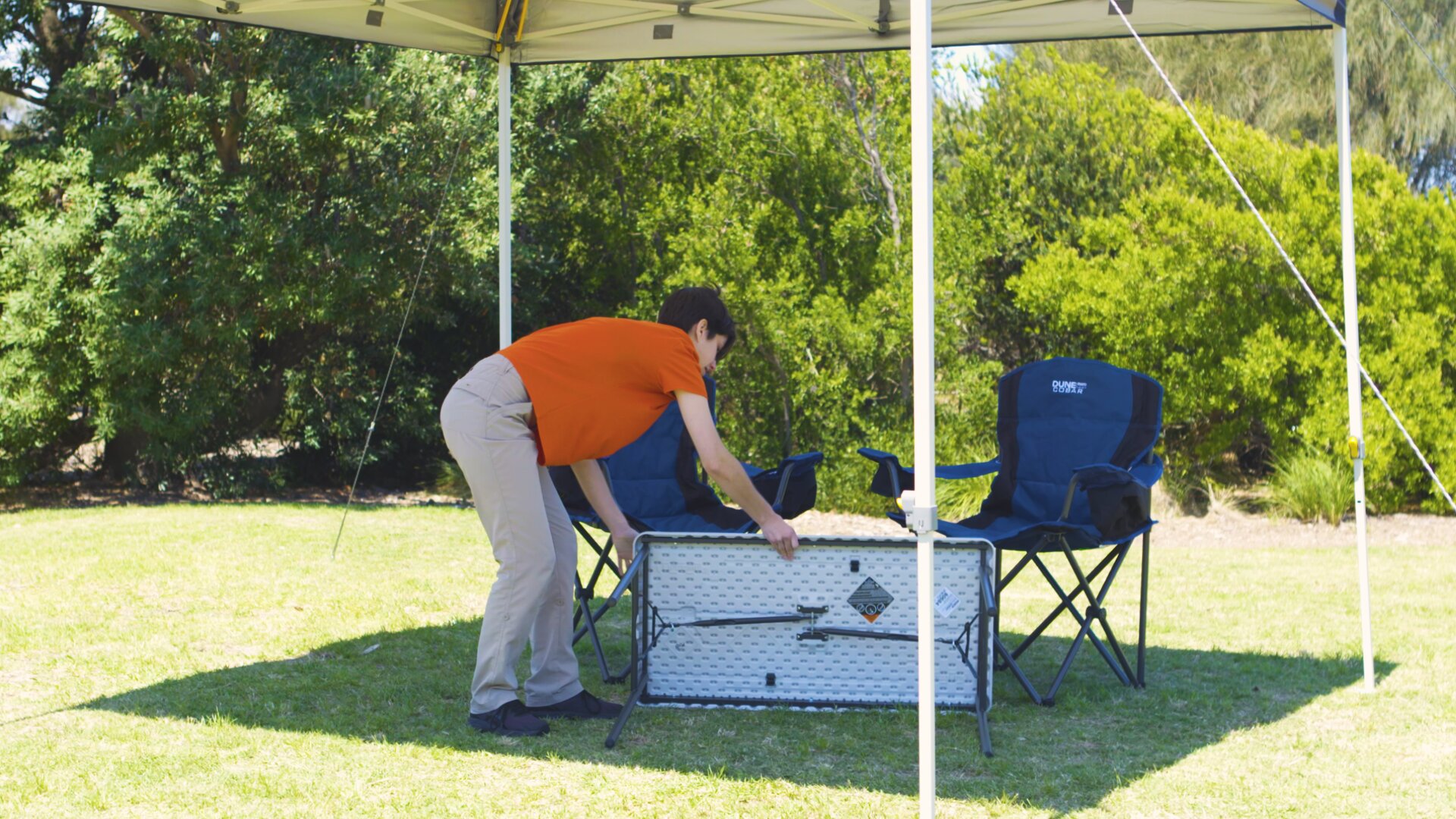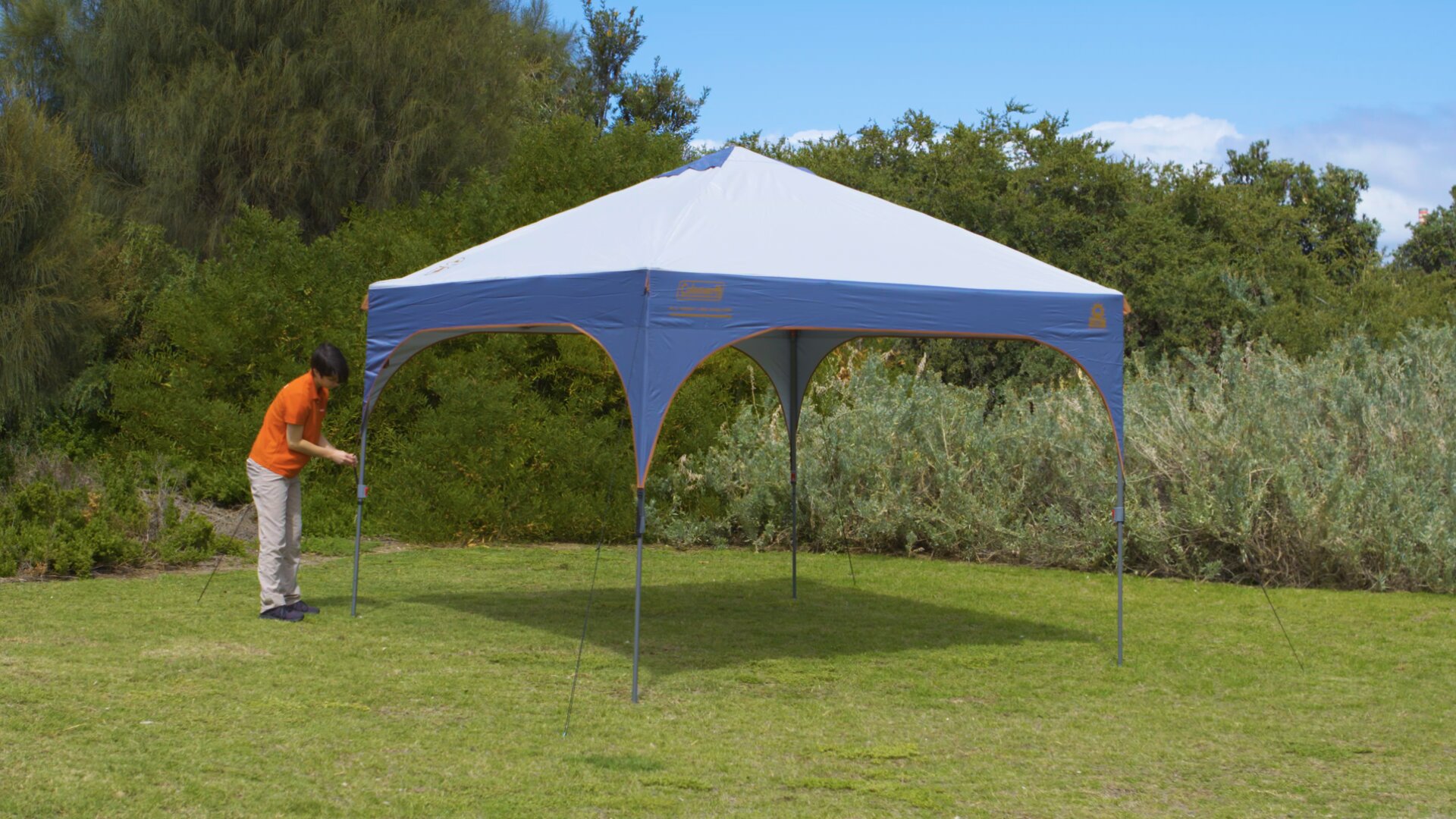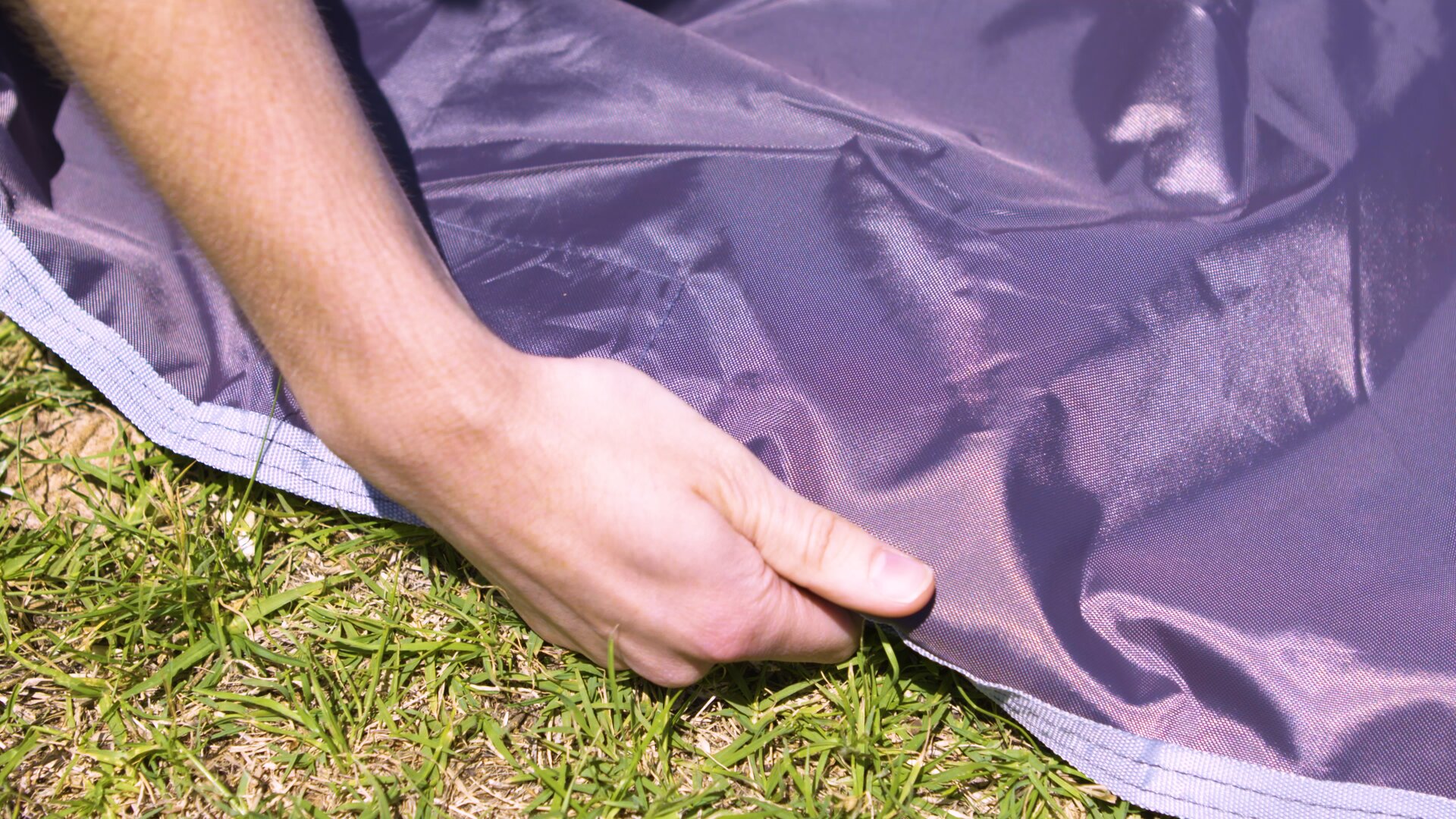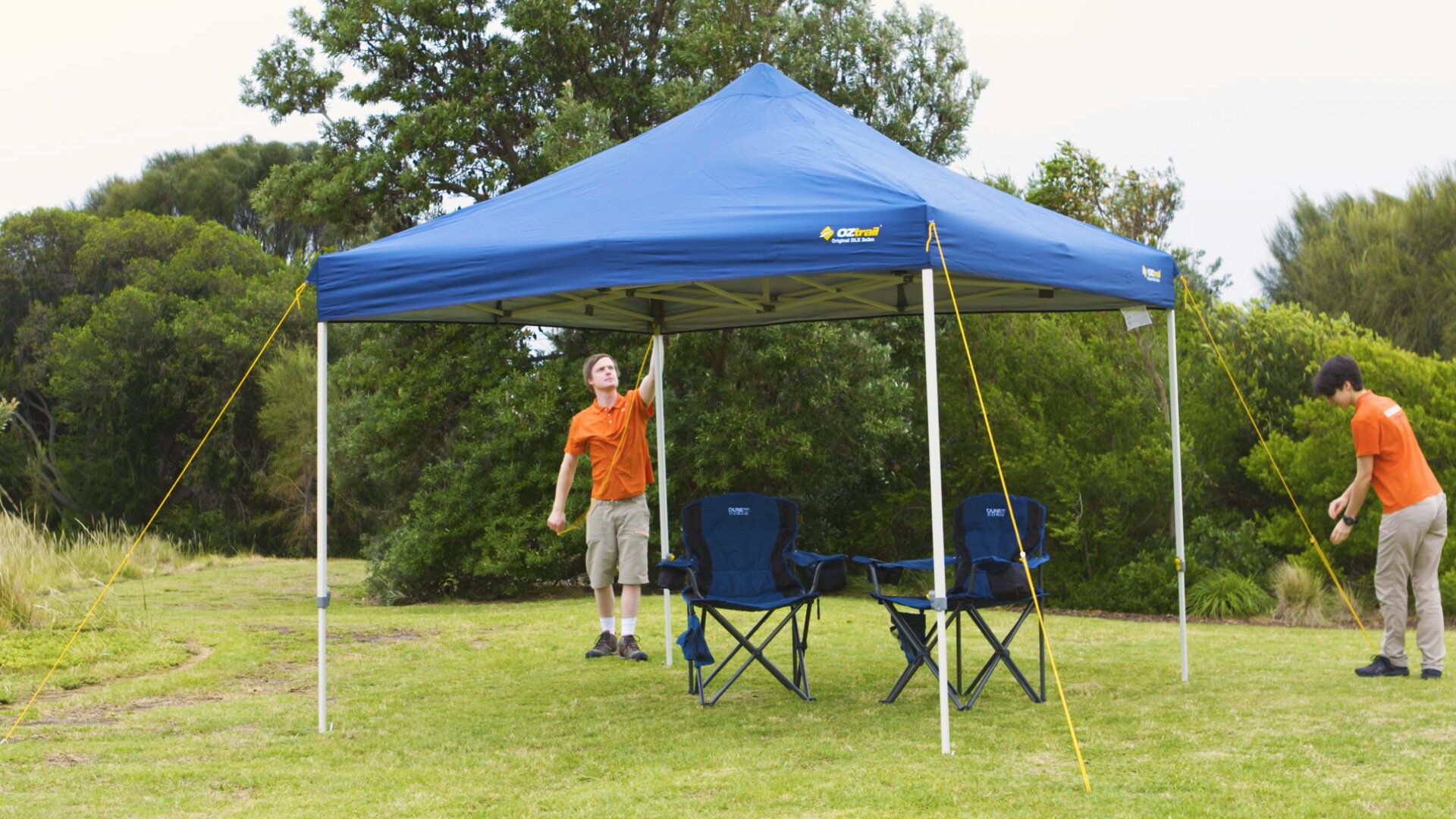| Your browser is not supported. | ||
|
Please browse our site using any of the following options:
| ||
Guide To Buying A Camping Gazebo Tent Or Awning
The great outdoors is great - except when it's raining or so hot you're frying like a sausage. With a portable shelter you can enjoy being outdoors without worrying about the weather. Attaching an awning to your tent or car protects you from the elements on camping and fishing trips, a sunshade is a must-have for beach days and sports days, and a gazebo is perfect for weddings, parties, BBQs, market stalls, music festivals and creating a protected outdoor play area for kids.
What is the best outdoor shelter?
There's no one-size-fits-all answer. It's different for everyone, because it depends on:
- Where you'll be using the shelter now and in future (will it be hot, cold, wet, dry or windy?)
- How much space you have to set up in (it has to fit within the dimensions of your set-up spot)
- If you're setting up a table and chairs (it'll need to be bigger than their total length and width)
- If you want to be able to adjust the shelter's height (to suit the sun, wind and rain changes)
- How fast you want to be able to set up and pack down the shelter (will you have any help?)
- How often you'll be using it for and how often (one day a week or for weeks of camping?)
- How long you want it to last (do you want a shelter you can use for many years to come?)
Shop Gazebos, Screens & Shades
Which outdoor shelter should you buy?
Choosing an outdoor shelter is easy when you break it down into these five steps:

1. Types
Gazebo
A gazebo is great if you're after a:
- Covered living area for camping.
- Shelter for your market stall.
- Protected party or BBQ area.
- Hangout space for festivals.
- Team hub for sports days.
- Shaded play space for kids.
- Beach shelter for a big family.
Gazebos can be set up on:
- Soft ground like sand and grass (with pegs and ropes or base pods to keep it secure).
- Hard surfaces (if it's set up outside, you'll need base pods filled with water or sand on each leg to keep it secure).
Sunshade
A sunshade, sunwall or shade shelter creates a shaded:
- Camping chillout area.
- Space for beach days.
- Area for picnics and BBQs.
- Play space for littlies.
Some sunshades:
- Come with a shade wall included for protection on windy days.
- Have optional walls you can buy separately if you want them.
Awning
Awnings are popular shelters because they can be attached to your:
- Tent for camping (if their attachments are compatible).
- 4WD for shade and rain cover at events and camp sites.
2. Size
When it comes to size, think about how and where you want to use your outdoor shelter:
- For outdoor dining - how wide and long does it need to be to fit your table and chairs?
- For how many - how many chairs or picnic rugs do you want to be able to fit under it?
- For food and drinks - how many coolers and bags need to be kept in the shade as well?
- For camping - it needs to be able to fit in the campsite along with your tent, car etc.
- For stalls - it has to fit in your site, and is it light enough to carry and set it up yourself?
If you're thinking about getting a gazebo:

3. Parts
The 9 Parts of a Shelter
Frame
The structure underneath the fabric that gives the shelter its shape (legs and roof struts).
Fabric
The type of material that's used to cover the frame and create the shelter canopy.
Ventilation
Mesh panels sewn into the shelter's fabric to:
- Improve air flow.
- Keep you cool.
- Prevent damp.
- Stop wind lift.
Walls
For extra protection, some shelters come with walls, or you can buy a separate wall kit:
- Fabric walls - to keep out the wind, rain, sun, mosquitos and bugs, and keep you warm.
- Mesh walls - to protect you from mosquitos and bugs and keep cool air flowing through.
Side walls can be attached to the shelter with:
- VELCRO® - strong, wide strips create a neat, taut finish that wind won't blow open.
- Zippers - take longer to attach than VELCRO®, but the shelter walls are more secure.
Ropes
Tied to the canopy (typically by reinforced tabs) and pegged into soft ground so theshelter's stable in the breeze.
Pegs
Used to connect the frame of some shelters to soft ground so they're secure in windy weather.
Base pods
Fill with sand or water then insert clip them around the frame legs so the shelter's secure on hard ground.
Lights
Some shelters have built-in ceiling night lights, and others have hooks you can attach lights to.
Bag
Some come with bags, and some bags have wheels so you can move it around on your own.
Frame
How sturdy the frame is will determine:
- How well it handles windy weather (a flimsy frame can warp in the wind).
- How long the shelter will last (if the frame warps it can ruin the shelter).
When it comes to the sturdiness and strength of the frame:
- Thickness - thicker legs and roof struts are sturdier and last longer (but also heavier).
- Metal
- Many shelters have steel frames but these can get rusty after getting wet.
- A high-quality powder coated steel frame will last longer than regular steel.
- Shock-corded steel poles strengthen the shelter and make the set up easier.
- Joints
- Plastic or nylon roof joints can buckle in the wind so don't last as long as metal.
- Metal joints are stronger so can absorb the shock of strong winds without buckling.
- Reinforcements
- Are used in the legs and/or roof of some outdoor shelters.
- Create extra strength so the frame's secure and won't bend.
Also factor in the frame's height adjustment options, which allow you to lower and lift the roof:
- As the sun's position changes (so you're not squinting) and rain intensity changes.
- Well-designed height mechanisms are easy to use and won't pinch your fingers.
- A low shelter over your tent or swag helps keep you dry in wet weather camping.
Fabric
Most outdoor shelters are made from waterproof polyester, and the key things to consider are:
- Waterproofing - some shelters are more waterproof than others.
- The water (or hydrostatic) head rating tells you how waterproof the shelter is.
- The higher the water/hydrostatic head rating, the more waterproof it will be.
- If you want one of the best waterproof shelters, choose one with one of the highest water/hydrostatic head ratings.
- Shape - rain water runs straight off dome shelters and won't collect on the roof.
- Seams - if the seams are sealed or heat taped, the fabric's more watertight.
- Sun protection - to ensure you're protected from the sun's harsh UV rays, look for:
- A silver coating inside the shelter canopy (this gives you better sun protection).
- The UV protection factor (E.g. some shelters have a 50+ UPF)
- Durability - the fabric's thickness determines how durable it will be:
- Thickness is given in denier (D), with shelter fabric's ranging from 150D to 420D.
- A higher D fabric is more waterproof, can handle stronger winds but it's heavier.
- A lower denier fabric is lighter and less durable than a higher denier shelter fabric.
- Shelters with higher denier fabrics won't rip as easily, so last longer than a lower D.
- Stitching -
- Quality stitching reduces the risk of the shelter's fabric ripping.
- Double-stitching and patches where the fabric and frame connect will last.
4. Set-Up Simplicity
How easy do you want setting up the shelter to be, and packing it up when it's home time?
It's important to think about:
- Whether you'll be doing it all alone or if you'll have other (adult) helpers.
- Giving yourself enough time to set up the shelter when you arrive at your destination.
- Doing a trial run at home so the set up and pack up isn't stressful the first time you use it.
- If the packed up shelter fits in your boot or on the roof racks (get the measuring tape out).

5. Quality
When weighing up which shelter to buy, think about quality versus cost, and keep in mind:
- If a shelter isn't secure and the wind catches it, it can:
- Bend and be hard/impossible to set up and pack down in future.
- Result in injuries to you or others, so everyone's safety is critical.
- Shelters with a light fabric and frame will be lighter but less durable than heavy shelters.
- Some manufacturers sell replacement fabrics, legs and struts so you can repair the shelter.
When it comes to how much you should spend on a shelter:
- If you just want a shelter the kids can play under in the backyard or at the beach, a good UVP rating protects their delicate skin.
- Cheaper shelters tend to be less waterproof than shelters that cost more, so you get what you pay for.
- If you want your camping trips and get togethers to be comfortable for years to come, it's worth spending a bit more on a good-quality shelter.

How much are outdoor shelters?
Anaconda outdoor shelters range from $50 to $400, with side wall kits sold separately for $30-$150.
When you go to the gazebos, screens and shades section on the Anaconda website, you'll see tick box filters down the left hand side of the page. Using these filters makes working out which outdoor shelter to buy simpler because you can choose to filter the shelters you see by their:
- Price - so you only see shelters within your budget on the page.
- Deal - so you only see shelters on sale or at clearance prices.
- Size - so you can see which shelters will suit the size you need.
- Colour - so you can find the specific colour you want fast.
- Brand - so you can see all shelters made by a specific brand.
- Storage Sack - so you only look at shelters that come with a bag.
- Side walls included - so you see sheltersthat come with side walls.
Other Camping & Hiking Essentials
Check out Anaconda's range of Camping & Hiking products available online or visit your local store.